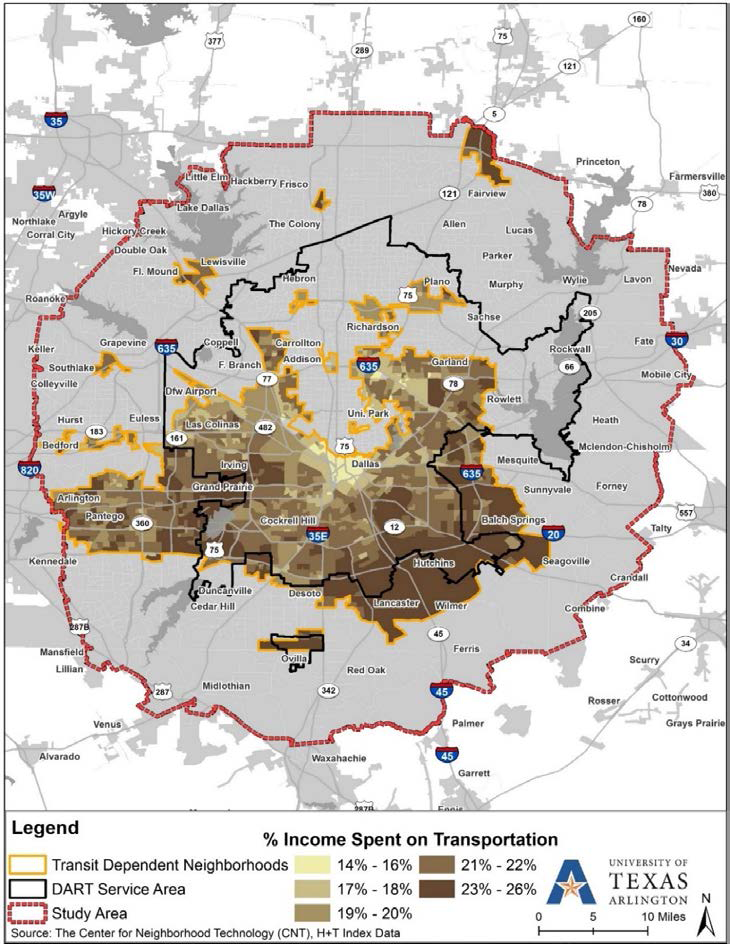The Dallas Area Rapid Transit (DART) system was created in 1983 as a bus system and was supported by a 58% vote. In 1989, the DART was the official Dallas area transit system and it continued to expand until June 14, 1996 when the light rail system was created. Despite its intention to provide meaningful and reliable transportation to Dallas residents, the DART has failed to equally serve all areas, directly harming the economic standing of South Dallas (Watkins, 2017).
In low-income areas of South Dallas, resident are completely reliable on public transportation because they cannot afford cars. The DART offers a very cheap option for transportation that in theory would allow South Dallas residents to commute to their jobs at an affordable price. The problem with the DART is that it is unreliable and disproportionately offers reliability to high-income areas that don’t rely on the DART as a sole means of transportation (Simek, 2017, par. 4-5).
According to Peter Simek’s 2017 D Magazine article on the DART’s unreliability, only 18-22% of DART light rail riders have access to high frequency service during peak hours, showing that most of the DART’s ridership can’t use the system in later hours when they may be commuting to or from work (par. 2). Riders that work regular 9 to 5 hours can rely on the DART rail system, yet the proportion of riders working these jobs is much smaller than those commuting during non-peak hours. Additionally, one third of Dallas residents to live within a half mile of a DART rail station or a quarter mile of a bus stop, making it very difficult to access public transit. If they are able to get to the stations or stops, the rides to their jobs in other areas of Dallas have transfers and many stops, making the rides long and inefficient. This puts a heavy burden on low-income riders who need to plan for any situation in order to get to their destination on time (Simek, 2017, par. 6-7).

When low-income residents cannot reliably get to work on time, it is harder to get and keep jobs, perpetuating the cycle of poverty that plagues Dallas. With the DART constantly shutting down from heat closures and a lack with frequency reliability, South Dallas resident can’t rely on the system to get them to their destination on time. This really damages their chance at climbing out of poverty and will continually keep low income minority people in South Dallas without prospects of changing their economic situations. Ultimately, the people in South Dallas are having to work much harder to get to their jobs on time using the DART system because there are less stations in southern areas of Dallas, despite it being the main ridership area. DART redesigning is taking place in northern regions where middle-class residents live despite most people in these areas not using the DART system (Dent, 2020, par. 15-18).
Curtis Corbin, a Dallas resident, started an organization called Southern Dallas Link to shuttle South Dallas residents to and from their place of employment for $20 per roundtrip. While the price is steep, it is much quicker and more reliable than taking the DART. Corbin is hoping to get grants to help fund the organization and lower the cost of the rides to $5 per roundtrip. Because of the DART’s failure to service the areas where it is needed the most, resident are having to find other ways despite already facing so many economic hardships (Dent, 2020, par. 19-22).
A case study based on Seattle’s public transit system suggested that the DART should allocate more funding to service updates that would prevent rail shutdowns on hot days. This would make the DART more reliable for those who rely on it solely. Also, it was suggested that they should improve how frequently the DART arrives at each station so that people don’t need to wait 30 minutes to an hour for a train on their way to work. The bus system could help with this problem by providing more access to transportation with more points throughout the community (Simek, 2019, par. 3-5).
Dent, M. (2020, April 20). DART Leaves Low-Income Residents Stranded. The Texas Observer. https://www.texasobserver.org/dart-dallas-public-transit/
Simek, P. (2017, October 23). Bombshell Report Reveals DART’s System-Wide Inadequacy. D Magazine. http://www.dmagazine.com/frontburner/2017/10/bombshell-report-reveals-darts-system-wide-inadequacy/
Simek, P. (2019, November 26). How to Fix Public Transit: A Case Study. D Magazine. http://www.dmagazine.com/frontburner/2019/11/how-to-fix-public-transit-a-case-study/
Watkins, C. (2017, August 14). Flashback: DART creation opened doors to mobility in 1983. Dallas News. https://www.dallasnews.com/news/2017/08/14/flashback-dart-creation-opened-doors-to-mobility-in-1983/
